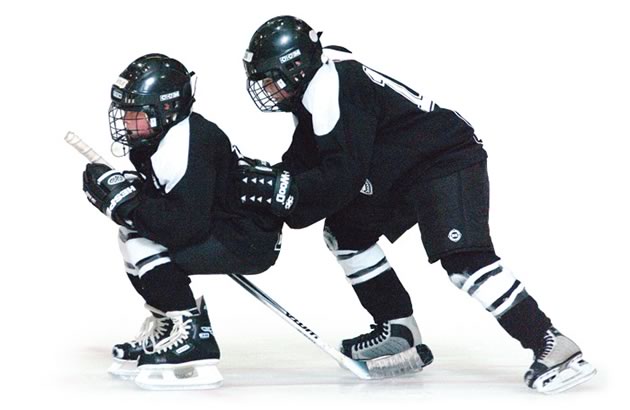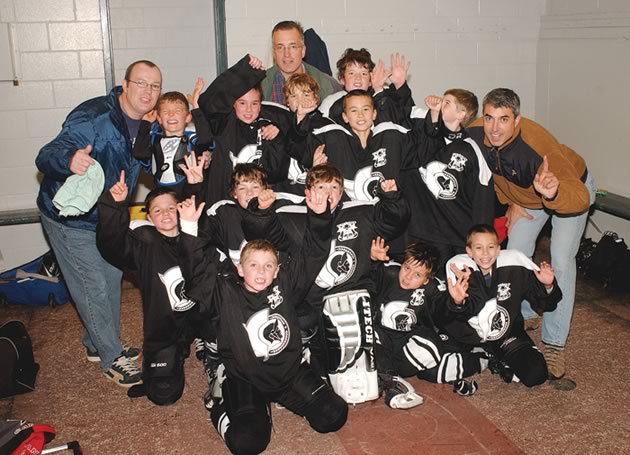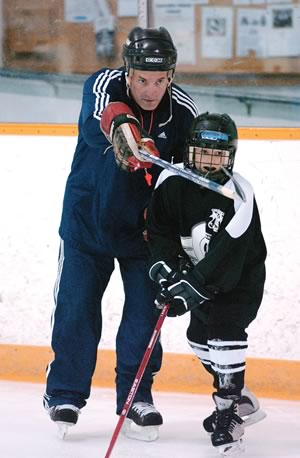Confessions of a Hockey Dad
Rediscovering the joy of the game with a team of eight-year-olds.
It’s Saturday afternoon at Orangeville’s Alder Street arena. Two teams in the Novice house league are battling for hockey supremacy. The game is close, but my team is behind by a goal and the clock is winding down. It’s now or never: I decide to pull the goalie.
When I was growing up, my father – an ex-Navy physical training instructor and a superb all-round athlete – coached me in several sports.
In our house we talked sports all the time: detailed techniques, advanced tactics, broad strategies and coaching methodologies.
I wasn’t a brilliant athlete, but did well enough in sports combined with academics to luck my way into an Ivy League school in the mid-eighties.
When I graduated my competitive hockey career effectively ended. I did play a couple of seasons in a beer league, but lost interest after seeing one too many testosterone-driven fits of pointless violence.
Eventually I stopped playing except for the odd game of shinny.
But in the summer of 2006, my seven-year-old son Isaac was showing some interest in the game. I’d been away from the sport a long time and I was nervous about what the game had become, about the seeming emphasis on winning over skills development, about the tales of ballistic parents, and even about the cost.
I hesitated. But as his interest grew, I had to ask myself, how could I not allow him the chance to play the game that had meant so much to me? I began to think about the prospect of getting involved – as a coach.
But would I have the time? Life was busy enough without taking on another extracurricular commitment. Would I have to deal with out-of-control parents? Most important, could I engage and teach effectively?
There was no way to answer these questions other than by diving in.
So I did.
I attended a coaching clinic, and found it surprisingly rigorous: lectures, videos, break-out sessions where we devised our own practice plans, and even an on-ice session where we took turns coaching one another. At the end of the weekend we walked away with a thick manual, DVDs and follow-up exercises we had to complete over the ensuing months. I was amazed at how well-structured the whole program was.
The next step was to decide where my son would play. We live in the country so it wasn’t clear which municipality we “belonged” to. I consulted with other parents and eventually decided on Orangeville, mainly because the schedule fit better with our family needs.
Then I contacted the Orangeville Minor Hockey Association to say I was interested in coaching. And soon I was invited to a meeting of fellow coaches for the Novice (eight year olds) house league. It proved to be an informal, amicable affair. The vibe was good.
Under the supervision of the convenor of our league, we divvied up players as best we could to make things fair.
We even got to choose NHL names for our teams. Having grown up in Alberta during the eighties, when Wayne Gretzky and friends were winning Stanley Cups, my choice was easy. We became the “Edmonton Oilers.”
…
The thing about pulling the goalie: it’s risky. You leave your net empty for the sake of an extra attacker and hope you can apply enough pressure to get that last-second goal.
When it works, it’s hugely exciting. But when it goes bad, it’s utterly deflating. And no one wants to disappoint a bunch of eager eight year olds, who play every game with Stanley Cup intensity.
From where I stand on the bench, my goalie is about fifty metres away. I yell at him, he sees me, I beckon him over.
But he just stands there, quizzically.
This is not going according to plan.
 On my team I had eleven players (there were no girls, but there were a couple of girls on other teams).
On my team I had eleven players (there were no girls, but there were a couple of girls on other teams).
We were a mixed bunch: tall, short, loud, quiet, skilled, uncertain. It also turned out that no one played goal. In fact, we were the only team without a goalie. Rather than appoint one, I decided to rotate players through the position.
I rationalized that it was a chance for them to see the game from a different perspective – and their willingness may have been aided by the fact that after every game the first order of dressing-room business was a resounding cheer for the goalie. In any case, we never lacked for a volunteer to don the pads.
One of the things we were told in the coaching clinic was that it is a good idea to hold a meeting with parents early in the year. It is important to have a good relationship and open communications with parents.
I booked a second-floor meeting room in the Alder Street centre one mid-week evening. Five or six parents showed up, fewer than I had hoped for, but better than none.
I introduced myself, recounted my hockey background and laid out my philosophy for coaching: that the emphasis for kids at this age – some of whom were just starting out – would be on learning basic skills and having fun.
I bemoaned the fact that we had so little time for practice – one hour a week. The research, I pointed out, showed that kids learned very little during games and that virtually all the yelling, cheering and admonishment by parents from the stands – or indeed by coaches from the bench – has little effect.
The parents shared their opinions and we more or less agreed on broad objectives. They were eager to help with various duties: providing healthy snacks after games, running drills during practice, and acting as assistant coaches during games.
The meeting helped set the tone for the year. Indeed, my group of parents were nothing at all like the screaming maniacs I’d read about. They cheered and yelled with the best of them, they positively encouraged and applauded the players. It was a fun, warm and respectful environment.
…
You see, there’s a technique to pulling the goalie. First, it has to be done fast. It has to be done when the puck is NOT in your end. And the player going on to replace the goalie has to be ready.
Trouble was, it was early in the season and we hadn’t executed this manoeuvre before. Nor had I warned the goalie before that we might do this.
So when I signalled to him, he hesitated, unsure of what to do. Eventually he began to make his way over. But just as he arrived at our bench, the other team gained control of the puck, slipped past our defence and scored an easy goal in the empty net.
…
During the first month of the season, the league dictated that we play games only – no practices – in order to ensure the teams were competitively balanced.
I would have preferred to get right into practices with the kids, rather than play games, but this was how the minor hockey administration wanted it.
All right, I thought, that approach reflects an attitude that puts too much emphasis on winning and losing – but I did see their point. No one wants lopsided games.
And the first few games were exciting. Getting to know the players, adjusting line-ups, trying to teach new skills and concepts “on the fly” during games: I found it exhilarating, and much more fun than I’d expected.
We did okay: won a few, lost a few. And then October came and we settled into the regular routine: practice on Saturday, game on Sunday.
Interacting closely with the kids during practice, focussing on important technical skills you just couldn’t teach during a game, and seeing them “get it” was the best feeling.
I was gratified to see the kids improve, but I was also curious to know what the parents thought. So, midway through the year, during one of our games, I left coaching duties to my assistants and sat among the parents in the stands. I asked each of them how they thought their child was doing – what skills had been improved and what needed more work.
I found that the parents were generally honest and clear-eyed about their child’s strengths and weaknesses. And in some cases they were seeing things that I was missing.
Over the Christmas week, instead of entering a tournament (which I gathered is sort of a tradition), I rented some ice at Teen Ranch and held a three-day skills-development camp for any players in our division. A dozen or so players signed up, including a few from other teams and even one or two of their younger siblings.
As the months went by, I saw the kids continue to improve, all of them in different ways and at different speeds. They formed friendships and fought hard to win their games.
During the round-robin playoffs in the spring, our lack of a regular goalie hurt us and we lost a couple of close games.
Ultimately, we finished near the bottom of the pack. That was disappointing, but as best I could tell, the kids had enjoyed the season.
…
I was red-faced. The other team had scored, we’d lost the game, my players were glum. My goalie was devastated.
I then experienced a difficult moment: having to eat humble pie. In the dressing room afterwards, with parents around, I apologized to the players. “You played a good game,” I said. “The way we pulled the goalie was my mistake, not yours.”
Minutes later, however, I glanced over and noticed that my goalie was in tears. I had to go over, sit by him, explain what I was trying to do, apologize and assure him that it was not his fault the way things had turned out.
One thing about kids: they’re usually pretty open with their feelings. And they’re smart. Part of me wished I could weasel out of the situation, but I knew it would be better if I owned up. How can we claim to be role models otherwise?
…
After the season, in the early summer, I invited the team out to my place for a barbecue.
The league had given us trophies for all the kids, so at the end of the barbecue I called up each of them, made a little speech about how well they had done and presented them with their trophy.
I also thanked the parents for their help and, being a sap, I even teared up a bit.
I’m into my second year now as a coach, and loving it. This year we are the “Ottawa Senators.” My son Isaac is on the team and improving from game to game.
More important, he and his buddies seem to be having fun. (A bonus: we’re even winning a few games.)
Despite my initial reluctance, I’m gratified to see that, in fact, the game can still be as much fun as I remember it. I even dare to imagine that, should Isaac one day contemplate becoming a coaching dad, he’ll look back at his early years in hockey as all kids should: as unalloyed fun.

Front: Ryley Anderson; 1st row: Jacob Stadnyk, Colin Dunn, Isaac Maxwell (Goalie), Mack Varcoe, Matthew Potkolabovic; 2nd row: Norm Dunn (Ass’t Coach), Noah Muise, Kyle Lepage, Justin Rock, Nicolas Potkolabovic, Alec Latham, Derek Lawr (Ass’t Coach); Rear: Tony Maxwell (Coach), Gabriel Stafford; Absent: Jake Lawr (Goalie), Matt Deverell. Photo by Mike Maloney.
PRACTICE vs PLAY
The manual for Hockey Canada’s National Coaching Certification Program notes that “there is a growing concern among ice hockey educators that, during hockey games, players do not have enough time to possess and control the puck in order to develop their puck control skills…
“There is also a concern with the quality of the individual skills of the average North American hockey player when compared to their European counterparts. Historical research has shown that there is an apparent overuse of games in North America, when compared to the number of practice sessions.”
According to a report by Calgary Hockey Development, one individual practice will give a player more skill development than eleven games collectively.
In a 60-minute Pee Wee hockey game, the report says:
Players have the puck on their stick for an average of 8 seconds per game.
Players take an average of 1 or 2 shots per game.
99% of feedback coaches give players is when they have the puck.
Players only have the puck on their stick for 0.2% of the game.
At the novice level (eight year olds), Hockey Canada recommends that 75% of practice time be spent on basic technical skills, 15% on individual skills and only 10% on team tactics.
As players get older, more time can be spent on team tactics and game strategies.







